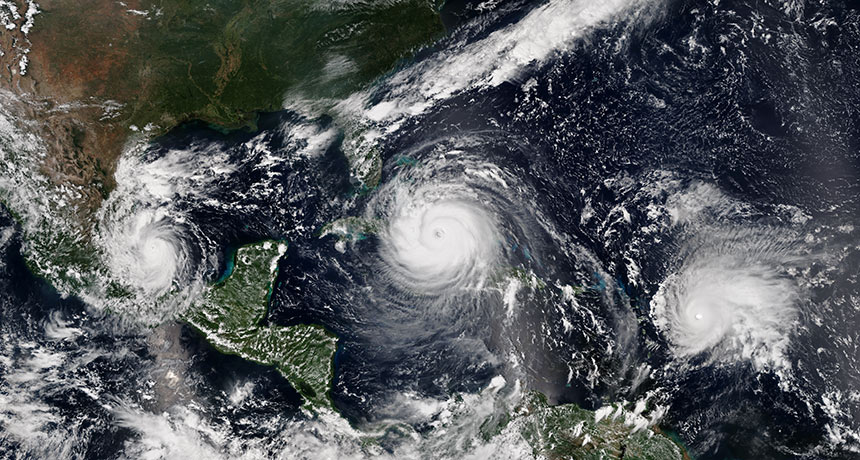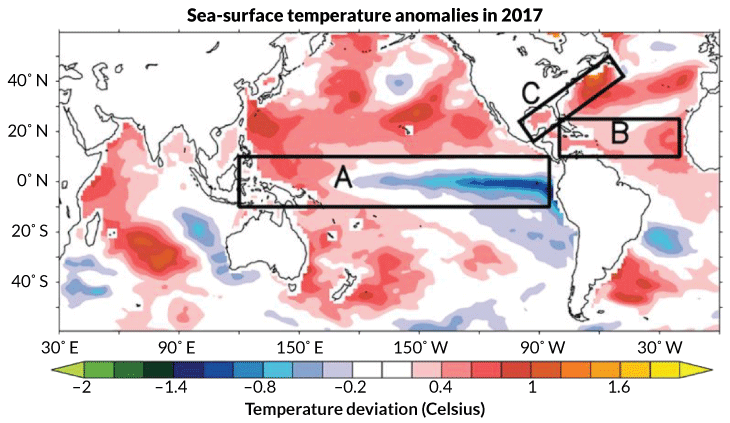Warm tropical Atlantic waters juiced the 2017 hurricane season
The ocean’s unusually high sea-surface temperatures were a bigger factor than La Niña’s effect on winds

ACTIVE ATLANTIC A snapshot of the Atlantic Ocean on September 8, 2017, shows three storms swirling in a row, including hurricanes Katia (left), Irma (center) and Jose (right).
NOAA View Global Data Explorer/Wikimedia Commons
- More than 2 years ago
Very warm waters in the tropical Atlantic Ocean were the primary cause behind the region’s many strong hurricanes last year, including powerhouse storms Harvey and Maria, a new study finds. And that pattern of ocean warming is likely to become more common in the future, fueling more strong hurricanes, the researchers say.
Climate scientist Hiroyuki Murakami, now at the at the University Corporation for Atmospheric Research and based in Princeton, N.J., and colleagues used climate simulations to investigate whether several factors might have influenced the busy 2017 hurricane season, which included six major storms with intensities of category 3 or higher. That’s about double the average number of major hurricanes observed each year from 1979 to 2017. The simulations suggest that the relative warmth of waters in the tropical Atlantic, rather than factors such as the onset of a La Niña climate pattern, was the strongest driver of the storms, the researchers report online September 27 in Science.
La Niña is a cyclical phenomenon — the meteorological flipside to El Niño — that brings cooler waters to the tropical Pacific Ocean and causes a change in the wind patterns over the Atlantic that can help strengthen hurricanes (SN Online: 6/9/16).
To suss out which was the most influential factor, the team ran several experimental forecasts using a climate model known as HiFLOR. Each experiment began with different sea-surface temperatures. In one scenario, the team used mean sea-surface temperatures for the tropical Pacific from 1982 through 2012 — essentially removing the effects of La Niña. “The model still simulated a very active season of strong hurricanes,” Murakami says. In another scenario, the team removed warmer-than-average temperatures seen along the U.S. East Coast last summer. That, too, didn’t seem to affect the number of major hurricanes.
But when the team removed the sea-surface temperature anomaly observed in the tropical Atlantic last year, “the major hurricanes had gone,” Murakami says. That disappearance suggests it was the temperature anomaly in the tropical Atlantic that was primarily responsible for the glut of major hurricanes.
Hot water
In 2017, Atlantic Ocean waters were as much as a degree Celsius warmer than the average temperature for the same period from 1982 to 2012. New simulations indicate that warm waters in the tropical Atlantic Ocean (box B) were the primary cause behind 2017’s large number of intense hurricanes, rather than anomalously cold Pacific waters due to the onset of La Niña (box A) or warm waters along the U.S. East Coast (box C).

Furthermore, he says, the simulations suggest a correlation not just between the warm tropical waters and storm intensity, but also between how much warmer the Atlantic’s tropical waters were compared with other tropical waters, such as those of the Pacific. When tropical waters are warm everywhere, Murakami says, atmospheric layers tend to be more stable, which isn’t favorable for hurricane formation. By contrast, anomalous warming in the tropical Atlantic Ocean compared with other parts of the world help hurricanes form.
The team’s projections of climate change and warming waters also suggest that this relative warmth will increase in the future, leading to larger numbers of major hurricanes.
Climate change attribution studies seek to determine if and how human-induced climate change is affecting weather events. Such studies have garnered increasing attention recently, with scientists last December saying three extreme events in 2016 would not have happened without climate change (SN: 1/20/18, p. 6).
Because Murakami’s team began its investigation even as the 2017 hurricane season was still under way, this work could be considered a real-time attribution study, he says. Attribution studies conducted in real time could ultimately help emergency planners better anticipate threats to communities, he adds. Another team of scientists conducted a real-time attribution study this month on Hurricane Florence, which made landfall September 14 in North Carolina. That study suggests the storm’s size and heavy rainfall were influenced by unusually warm ocean waters (SN Online: 9/13/18).
Some researchers disagree that the relative warmth between the tropical Atlantic and the Pacific is more important than just how hot the water got. The new study “is solid work” that demonstrates the importance of the tropical Atlantic compared with natural climate patterns to 2017’s hurricanes, says Michael Mann, a climate scientist at Penn State. “But I have a different interpretation” of the data, he adds. He and others have previously shown that the absolute warmth of those waters is better at predicting seasonal storm activity, he says.
Mann notes that Penn State’s own predictions for the 2017 hurricane season used absolute sea-surface temperatures and predicted a total of 15 storms for the season — close to the final tally of 17. That demonstrates that those absolute temperatures are a better predictor, he adds. “I prefer to go with what we know is true in the real world.”






